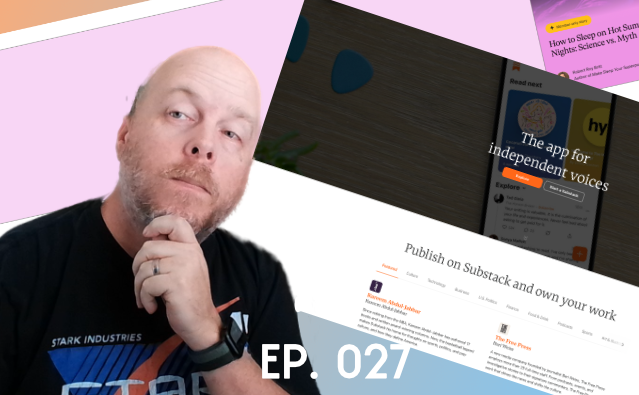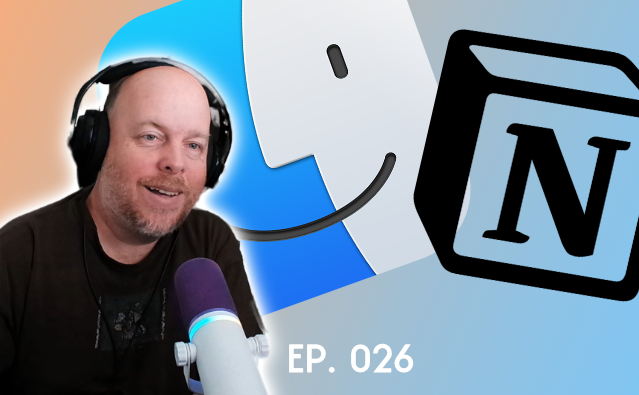Why Creators Need to Own Their Digital Space
Don't build your creative empire on rented land. When platforms change their algorithms, your content shouldn't disappear with them. Own your digital home first, then share from there. Your brand deserves better than living in someone else's apartment complex.

Today I want to dive into something that's been on my mind a lot lately—something that affects every creator trying to build a presence online.
Have you ever thought about what happens when the algorithm changes overnight and your digital content just vanishes? I'm not being dramatic here; this happens constantly in our creator economy. One day you're riding high with engagement, the next you're practically invisible because some tech company tweaked their code.
The answer to this problem might be simpler than you think. And it starts with you taking control of your digital landscape.
The Rental Trap Most Creators Fall Into
Most of us rely on social platforms to carry our content. We post on Facebook, Instagram, Twitter (or X, or Blue Sky, or whatever we're calling it this week), and we assume that content lives there forever, right?
Wrong.
What happens is that you're posting to a place that isn't your own. You don't control what happens to your content once you hit send or enter or OK. It basically lives on a rented or leased space that you have absolutely no control over.
Let's be real—it's at the whims of large corporations or billionaires who couldn't care less what happens to your content or to you at all. That's not me being cynical; that's just the business reality of these platforms.
The Substack Problem
Take Substack as an example. When you look at the URL, it's substack.com/whatever-name-you-set-your-account-up-with. That creates a real issue with brand perception.
When people think of your content, they're not thinking, "I'm going to [Your Brand's] website dot com." No, they're going to substack.com. So already you're at a disadvantage because people are associating you or your content with Substack.
The mindshare of what people think of as your digital space lives on Substack. That's not your home—it's just an apartment. And I don't say that to be mean, but to highlight the reality of the situation.
It's an apartment that you're renting month to month or maybe you got a six-month lease on. People don't say, "Oh, we're going to your house." No, they're going to your apartment. And what happens in six months when the management company says, "Yeah, we're kicking you out because we're turning all these apartments into condos. Find another place to live. Sorry!"
The "But It's Free!" Argument
I know a lot of folks get caught up saying, "But Josh, it's free! I don't have to pay for server costs! I don't have to pay someone to handle the admin side of things."
I understand that completely. Believe me, I do. Running your own site isn't necessarily cheap or simple. But here's my counter-argument: take care of your digital space because that's pretty much all you really have.
Your name is who you are as a brand, as a content creator, as a podcaster, an artist, an author—whatever your creative pursuit. And you really should take better care of sending people to a website that you own.
The Professional Image Factor
Having your own website gives a more professional appearance to things. Let's take a step back in time, shall we?
Back in the day, all we really had was websites and email. We didn't have social networks. I'm talking pre-Facebook, even pre-MySpace. People set up accounts on AOL.com with yourname@aol.com.
Fast forward a decade or so. When someone hands you a business card today and you see their email is theirname@aol.com, what actually goes through your mind? Either this person is really, really old and part of the boomer generation, or they're stuck on AOL, or they're still paying for AOL when they shouldn't be.
It's not a professional look when you have an AOL.com or a gmail.com email address on your business cards. If you're trying to promote your business and say, "Hey, I'm a fisherman, I go out and catch crab, email me at fisherman@aol.com"—people aren't going to take you seriously.
Why? Because you don't have ownership of your brand. You don't have ownership of your brand awareness with everybody else.
The Same Thing Applies To Your Content Home
This same principle applies to your blog or website. With Substack or similar platforms, yes, I understand they give you space. It's kind of like a social network for blogs. Yes, it gives you a place to help advertise your content.
But at what cost? Yes, it's free, but you don't really own your home.
Some people will say, "Well, Substack gives you all this distribution network to help get your site seen by many other readers or viewers or listeners." And that's true! They're even starting to get into short-form video content because, you know, everybody's gotta do that.
But at what cost to your brand? People think of your blog, and the first thing they're gonna say is, "Oh yeah, I saw, I read your blog post on Substack." They're not going to say, "I read your blog post on your website."
Finding The Right Balance
Now, this is kind of a catch-22 situation. There are hundreds of thousands or even millions of users on Substack who are perfectly happy with this arrangement. And you know what? That's perfectly fine!
I'm not here to say using one platform over creating your own website is something you should be ashamed of. It's something you should consider if you're very serious about your brand and creating content for your brand.
Because, like I said, most people are going to associate you with whatever platform you're on. They're not going to say, "Yeah, I saw your website." They're going to say, "I saw your videos on YouTube."
The Video Content Exception
I know some things probably aren't going to fit my overall argument, especially for video content creators. It's like you either are on YouTube or you host it yourself through PeerTube or Vimeo—there really isn't any other way cheaply, or low cost I should say.
Video is expensive to host. It is one of those things that perhaps blows my entire argument out of the water. And yes, setting yourself up on YouTube or PeerTube or if you're a filmmaker, Vimeo (because Vimeo is more geared toward the filmmaker side of things) makes sense.
In that case, having your stuff sitting on, let's say, YouTube, that's an exception. Because, believe me when I say, video hosting is very expensive. If you don't have infrastructure set up for video hosting, you're looking at thousands of dollars per month if you have a large following or if one or two videos go viral and you get several million views. Your server cost is going to go right through that roof.
For Those Just Starting Out
Using Substack and Medium in that case is probably a good idea if you're just starting out your content creation journey and looking for a place where you don't need the technical know-how to create websites or blog posts.
I don't want to knock these platforms or the people who use them successfully. I'm just giving insight into what I believe (and many others believe): if you want to build your brand, going the platform-only route is probably not the best long-term strategy.
But these platforms are perfectly fine for people who are starting out and want to create something without the technical know-how of self-hosting a Ghost blog site or newsletter site, or any other platform like Write Freely. They don't have the technical know-how to set up a server, install software and Docker containers. And you're probably listening and saying, "I have no idea what you mean—Docker? What does that mean?"
The Medium Example
Looking at Medium, for example, they have membership plans: $5 a month or $60 a year as a Medium member. You get to read member-only stories, support writers you read most, earn money for your writing, listen to audio narrations, read offline with the app, access their Mastodon community, connect your custom domain, and create your own publications.
That last part—connecting your custom domain—is a good thing because, for $5 a month, people are coming to your domain and don't immediately see it as a Medium platform. My earlier argument about branding gets addressed somewhat.
The Politics of Platforms
There's also the consideration of the political associations of certain platforms. Some people have claimed that Substack caters to far-right ideology. So if you pay for a Substack membership, some argue you're indirectly supporting those ideologies.
I'm not taking a position on this, just pointing out that platform association can have unintended consequences. And for me personally, I'm tired of the political stuff right now because it's pretty much everywhere.
The Theming Limitation
Your Substack page is essentially going to have the same look as many other Substack pages because there is very little theming capability. And don't get me wrong—that's perfectly fine for many creators. They don't care if it looks pretty or unique.
My 2TonWaffle dot com site has a similar layout to many other sites. My thinking is that unless you custom code or purchase a premium theme, there really isn't that much visual difference between what your site on Substack could look like versus on Ghost or on Medium.
It's something you have to consider if you're serious about furthering your content creation as a journey or as a business. Some people just want to do this as a hobby, and that's perfectly fine.
Finding What Works For You
For me, I'm gearing this podcast and my little 2tonwaffle metaverse more toward the business side of things. I'm focusing on maneuvering certain elements like the website, YouTube channel, PeerTube and the content I'm producing in a way that helps others.
All in all, your decision on creating your brand for your business requires making choices about how your content, clients, and viewership perceives what you make or what you want to present to the world. By using certain platforms, you have to take their perception into consideration.
The Bottom Line
Hopefully, with this complete rambling post (which is my style, if you haven't figured that out yet), you might have gotten some semblance of figuring out what's best for you.
I'm just here to show you that if you want to take your brand to the next level, create a domain for your brand name and set up your website. That's all the meat and potatoes of what I'm trying to say here.
If you create your website, create the content on your website, and share that content out to Blue Sky or Twitter or Facebook or wherever else to lead back to your website, it's a much better experience—probably for yourself, your content, and eventually your members, viewers, and people interested in what you have to say.
You can still utilize platforms like Substack for newsletters if you want. You can use Medium, Beehive, Ghost, Fourth Wall—there are many places to create your newsletter if that's what you're interested in.
But it's important to have that domain, not just for a home for your content, but for your professional emails too. It's more professional to have yourname@yourdomain.com instead of aol.com or gmail.com.
Take control of your digital space. Your future self will thank you.
Until next time, later taters!
—Josh Bailey, 2tonwaffle.com


